Where Even the Run-of-the-Mill is Extraordinary
An elaborate, well-made door is the crowning piece to any building. At Blue Ox we joint all our wood doors with 4 inch tenons. The mortise and tenon joint is the strongest, most reliable, and visually pleasing joint we have come across, and has been used since the times of the ancient Egyptians. From the lightest summer-time screen door to the heaviest fortress-style solid oak entrance door; from mahogany French doors to old world redwood pocket doors; each is made to withstand a lifetime of use, while maintaining its accurate angles, solidity and beauty.
"Wood doors—almost every house has them, yet as commonplace as they are many of us take their construction for granted. In truth, a door takes more abuse and strain than any other component in a house. These mighty wooden warriors face the devastating effects of gravity on a daily basis—and as any old man or woman can testify gravity can be a fearsome opponent.
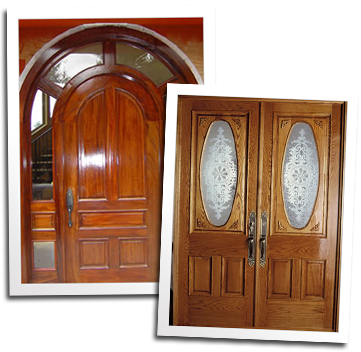
"Because any door (except for a pocket door) is hung from hinges on only one side, gravity is constantly pulling down on the structure, fighting to turn rectangular doors into parallelograms. Throughout history, man and door have fought a tireless battle against the forces of nature. Of course, doors and nature have never gotten along! That was the very reason that the first doors were invented, to keep weather outside. The first doors were simple fur flaps, and though they were good at stopping wind or rain, they weren’t very persuasive in halting unwanted entry. As housing became more permanent, it became apparent that a more solid door was going to be necessary.
(Above Left): Specialty arch top mahogany entry door. Complete with arched glass panels. (Above Right): A set of custom Victorian solid oak doors for a home in New York. Custom designed from an old photograph, these doors are two and a quarter inches thick with hand carved oak corner pieces around the glass on both interior and exterior. Finished with three coats of Marine Varnish.
(Far Left): These beautiful specialty redwood doors with burl panels were custom built for a Victorian style home on Portero Hill in San Francisco. The home owner came to Blue Ox after her three previous restoration attempts fell somewhat flat. Eric took her on a three-day tour of Victorian homes and in the end she had him design and build all the exterior work on her house. (Near Left): A set of custom African mahogany French doors manufactured by Blue Ox for Iris Byers.
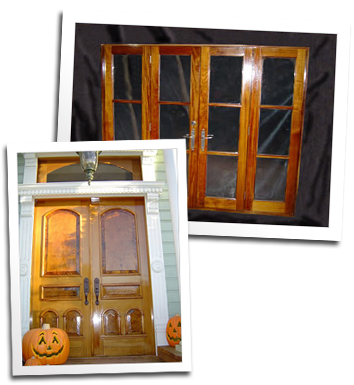
"The first attempts to answer this problem were solid pieces of wood split from the largest logs they could find. The size of the door was limited to the size of these primitive boards. Early craftsmen put two and two together, and soon simple doors were being constructed. They could take two or three horizontal pieces to establish the width and then nail in enough uprights to fill the spaces. But soon gravity came knocking on the metaphorical door. These early portals would sag so much that in their later years it was almost impossible to drag them over the floor. This sag was worsened by the use of nails because over time the expansion and contraction of the door made the nails loose. To make matters worse, all the uprights would expand with the weather. A door that fit perfectly in the summer would swell to the point of sticking in the winter time.
(Right Top): Custom interior doors built for the Leland Stanford Mansion restoration in Sacramento. (Right Bottom): Built for the video room at the visitors' center of Redwood National Park. The door is 8 feet tall and four and a half feet wide with two six foot side lights, and it is made from two and a half inch thick all heart clear redwood.
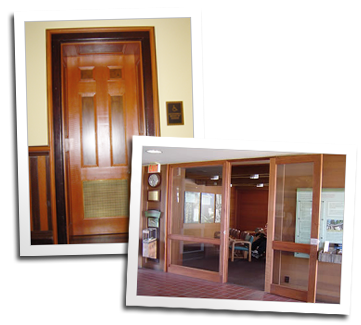
Wood Doors of Medieval Europe
The craftsmen of medieval Europe tried to solve this expansion problem by making doors from two layers of planking, one horizontal and one vertical. To answer the loose nail problem they used extra long nails and clinched or “deadened” them. Extra long hinges were used to control sag. All this effort paid off, it made a very solid “fortress type” door that held up longer than any of it’s predecessors but it had a few major flaws. (1) It was extremely heavy, giving gravity even more to work on and, (2) water was trapped between the two layers making a perfect environment for rot.
(Far Left): A pen and ink diagram from Dan Brett's book Tales of the Blue Ox. Note that the hinges extend to cover more than half of the width of the door. These longer hinges are still available today from various specialty shops and can add a medieval feel to your entryway, as well as helping to reduce sag. (Near Left): This large fortress style door was constructed by Blue Ox for Gary Barker and the Dogwood Estates Winery. It is 83 inches tall, 51 inches wide and is made out of clear all heart vertical grain old growth redwood. The wood was salvaged from an old water tank that had been on the winery property for generations.
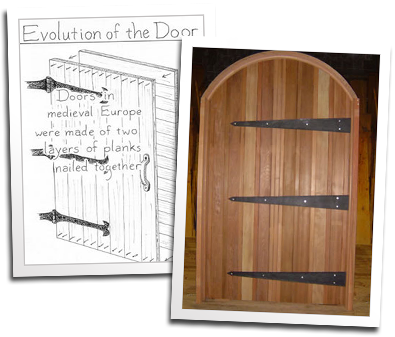
The next big advancement came with the introduction of Z bracing. Z bracing throws the effects of gravity through the diagonal back to the hinges, finally producing a door that wouldn’t sag yet was light. The nails were still deadened. This type of door has been in service for hundreds of years
In the Victorian age, form followed beauty. Functional doors held little value to Victorian home owners if they weren’t beautiful. Thus the stile and rail door was invented.
(Near Right): A pen and ink diagram from Dan Brett's book Tales of the Blue Ox. The Z braced wood door is generally very simple and affordable and can still be found around the world, especially in barns and sheds. (Far Right): Custom arch-top entry door with curly redwood panels, made from salvaged old growth redwood.
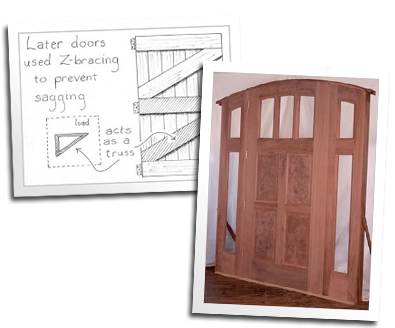
These doors didn’t sag because the rails act like the Z bracing of earlier models. It didn’t swell because only the swelling of the stiles effect the size of the door. The individual panels can shrink or swell with the seasons, adjusting to fit inside of their pockets without affecting the size of the rest of the unit. Most importantly, it used the oldest wood joint in history, the mortise and tenon. This joint, found in ancient Mesopotamia, eliminated the need for nails and was very versatile in the beauty department.
Another movement in Victorian Door evolution happened with the addition of small squares of colored glass around the center clear glass, and/or the same small squares in the sidelites or transom. Historically this design in Humboldt County dates the house between 1900 and 1910, for this was the period of popularity for colored glass squares.
(Far Left): These exterior custom doors (and flowery elements) were designed and built for a commercial building at 2nd and D Street in Eureka. Though the businesses have changed a few times over the years, our Blue Ox doors are still standing proud. (Near Left): This custom Mahogany Entrance features a highly decorated front door with sunbursts, raised panel sidelites and full transom, all set off with custom insulated colored glass by Ed Waters Custom Glass. Ed can be reached at (949) 548 0988 or rdl-usa@mindspring.com. (Bottom Left): A pen and ink diagram by Dan Brett. Though the stile and rail door can come in many designs, all utilize the same principle. The panels may be glass or wood, there could be four of them, or thirty-five, but they all rely upon the same construction principles.
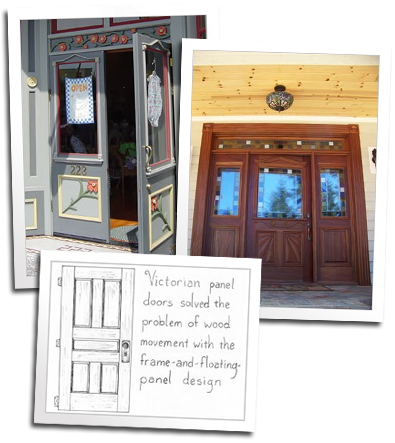
Anatomy of a Door
Today Blue Ox keeps alive the tradition on the stile and rail door, though as you can tell we also manufacture doors of many kinds. No matter what you need, if you trust your entryway to our craftsmen you are sure to have not only a functional portal, but also a work of art that will be cherished by generations to come.
For questions or to get a quote on your custom wood door project, email Eric Hollenbeck.
(Far Right): Multi-pane redwood French doors built for a house remodel in King Salmon. (Near Right): A pen and ink diagram from Dan Brett's book Tales of the Blue Ox. Here you can see how mortise and tenon “lock” the stiles and rails together. Because of this mechanical joint the craftsman isn’t relying on the glue to keep the integrity of the door over the years. Because wood expands across its grain, note that the only potential for horizontal expansion is along the styles and the only vertical expansion is along the rails. Click on the diagram for an enlarged version.
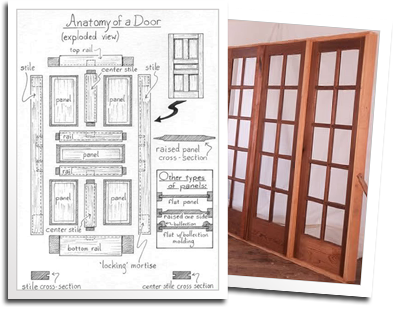
While the information on this website is believed to be true and accurate at the date of publication, neither the authors, webmaster, nor Blue Ox Millworks can accept any legal responsibility for any errors or omissions that may have been made. Prices listed on website are subject to change. © . Blue Ox Millworks. All Rights Reserved. Web Design by DHD